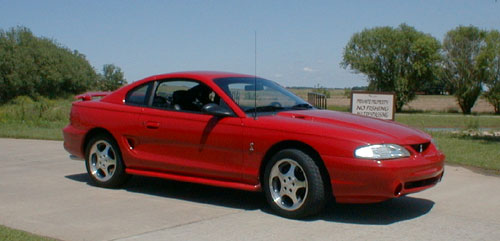

Everything you wanted to know about 1994 Cobras but were afraid to ask My car is 1994 Rio Red Cobra #1974 of 5009. Red was one of three exterior colors available for 94-95 Cobras, the other two colors are black and white. It has black leather interior and is hardtop. From the factory, it is equipped with a Cobra-spec T-5 manual transmission, which featured phosphate coated gears and strengthened teeth. The powerplant is mated to the tranny via a high-density Valeo clutch assembly. Under the hood, the 5.0L "SHO" (special high output to designate Cobra 5.0L) motor resides. From the factory, it is a standard 5.0L High Output Mustang GT motor equipped with revised iron heads (based off GT-40 design), 1.7 Crane roller rockers, 70mm mass air, 60mm throttle body, 24lb/hr fuel injectors, Cobra upper intake, Cobra lower intake, and slightly underdriven accessory pulleys. Power is SAE rated at 240 HP but most 94 Cobras have about 250-255 HP stock. In the quarter mile most stock 94 Cobras run mid to high 14s and trap anywhere from 94-96 mph. The track conditions, locations, and other factors can change this though.

First Mod: Steeda Tri-Ax Shifter
Like most 5.0 owners I have modified my stang a bit. I started by adding a Steeda Tri-Ax shifter. It is all billet aluminum with positive stops to prevent tranny damage from overshifting, and has an adjustable handle with 2 heights. It cost me 167.00 from Partshopper. Installation took about 30 minutes and was very straightforward. All you need are standard tools plus some Ultra Black RTV sealant. Don't use too much, just a thin bead. You also might need a 2X4 to remove the stock shifter. Put the wood on the base of the shifter and hit it with a mallet on the other end, breaking the old gasket seal. I give the shifter a 10/10 for improvement. It makes shifting easy and more fun than the sloppy stock unit.
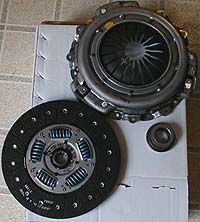
Second Mod: Ford Racing "King Cobra" Clutch disc and pressure plate
Shortly after I got the car the throwout bearing started acting up. It would grind and make noises when I was sitting at a light, and squeal as I let the clutch out. I decided that while I had the tranny out and the clutch apart I would toss in a new unit. So, following people's advice from the Corral and Stangnet, I ordered a Ford Motorsport King Cobra clutch kit which included pressure plate, friction disc, and throwout bearing. Installation was done by a guy I know here in town, we did the install in his garage at home where we had access to a monster jack and jackstands along with an air compressor and a host of tools. It took about 5 hours, with 2 hours being spent looking for another swivel socket to access the last remaining tranny bolt. The first swivel socket (Snap-On) was destroyed by the impact hammer. After we got the right tools and dropped the exhaust and everything, it went smoothly. We did not resurfact the flywheel, just a lot of brake cleaner to keep it clean. We also did not replace the pilot bearing, which we probably should have, but nobody had one in town! The clutch has a fairly heavy feel and grips hard. The throwout is totally quiet also, which was the main goal. I give the King Cobra 7/10 for improvement, and a 5/10 for ease of installation. Be sure you have good instructions when you do yours, and raise the car as high as possible, and lastly dont forget the alignment tool.
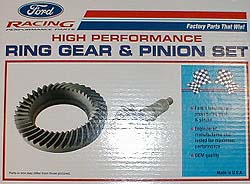
Third Mod: Ford Motorports 4.10:1 Gears
After the clutch replacement I got some 4.10 gears from Summit Racing for $149.99. They are made by Ford Racing and are supposedly the most reliable gears for an 8.8 rear. This makes sense in a Ford vehicle. My gears were installed by Powerhouse Performance of Midwest City, OK for a price of only $150. They did a great job and there is no gear whine. However, my driveshaft will need to be replaced as it is vibrating a lot now at highway speed. When I did the gear swap I bought some Red Line synthetic gear oil for 7.99 per quart along with some extra friction modifier in case I needed it. 2000 miles trouble free so far. The only bad thing is the lack of traction in 1st, 2nd, and some of 3rd gear. I would advise drag radials for the track. My best 60' time on my bald street tires is 2.29.
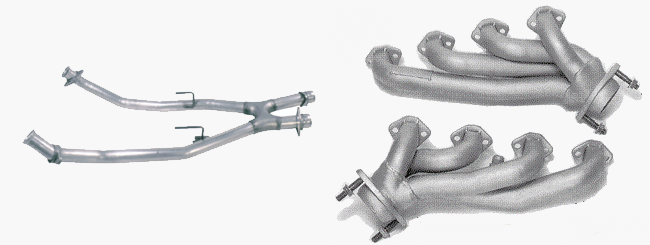
Fourth Mod: Mac unequal shorty headers and off-road H-pipe
I also added some Mac 1 5/8" unequal length "shorty" headers (the ones shown above on the right). They cost 149.99 and took about 4 hours to install, but if I had to do it again I could do it in half that time. I also added a Mac 2 1/2" offroad H-pipe (109.00) to replace the stock pipe which houses the 4 catalytic converters. Installation for the offroad H-pipe was very easy and took about an hour. I noticed an improvement right away - it's louder, its deeper, and it pulls harder than before. Just looking at the Mac headers next to the stock headers you can see why they work better. The stock manifolds' primaries are pinched off so that the robot can bolt them on faster. The mac headers are not pinched off, the ports are large and the tubing fat and smooth. This equates to exhaust being pulled out faster so the engine can work better. Ditto for the catalytic converters. I give the headers a 6/10 for improvement and the offroad pipe a 7/10. You might want to consider a cat-back system which includes tailpipes and mufflers, although I did not. It will make your sound even better and increase the flow a bit more.
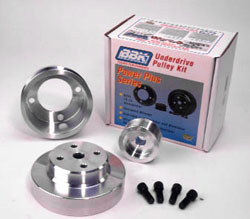
Fifth Mod: BBK Aluminum Underdrive Pulleys
For 60 bucks, underdrive pulleys are a good bang for the buck mod. MM&FF magazine got 12 horses at the wheels using similar pulleys on their stock 5.0L GT. I chose BBK because they were cheap, and lightweight. The aluminum material looks great as well, really eye catching in the engine bay. The low rotational mass also aids in maximum horsepower. One of the "basics" for N/A motors, I consider pulleys to be a good mod to do. However, most superchargers won't work with them, they require stock waterpump and crank pulleys. If you experience charging problems or cooling problems, swap either the stock alternator pulley or the stock water pump pulley back on, leaving the underdrive crank pulley, and get a new belt. Many racers choose a single crank pulley rather than a set of three.